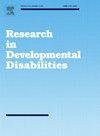虚拟现实CPT对多动症儿童的预测能力在不同国家有何不同?阿根廷和西班牙儿童的跨文化研究。
IF 2.9
2区 医学
Q1 EDUCATION, SPECIAL
引用次数: 0
摘要
背景:尽管许多研究分析了新型连续表现测试(CPTs)在诊断ADHD方面的有效性,但很少有研究考察文化因素如何影响其有效性。目的:本研究旨在分析居住在西班牙和阿根廷的儿童样本在虚拟现实CPT中的表现。方法与步骤:138名学生参与本研究。他们的年龄在6至16岁之间,平均年龄为10.38岁(SD = 2.46),并被诊断为ADHD。结果和结果:佣金是两个判别模型中唯一显著的变量。在西班牙人群中,委员会变量被证明正确分类了49.4% %的三种类型的ADHD表现。然而,在阿根廷人口中,佣金变量正确分类为68.3% %。结论和意义:这些结果可能因不同类型表现的严重程度而有偏倚。事实上,我们似乎有理由认为,病情越严重,Aula Nesplora对ADHD三种表现形式的预测效果越好。这些结果强调需要考虑在儿童成长过程中对日常生活有显著影响的其他变量。本文章由计算机程序翻译,如有差异,请以英文原文为准。
How does the predictive capacity of a virtual-reality CPT for children with ADHD differ by country? A transcultural study with Argentine and Spanish Children
Background
Although many studies have analyzed the effectiveness of novel Continuous Performance Tests (CPTs) in diagnosing ADHD, very few studies have examined how cultural factors influence that effectiveness.
Aims
The present study aimed to analyze performance in a Virtual-Reality CPT in a sample of children resident in Spain and Argentina.
Methods and procedures
138 students participated in this study. They were aged between 6 and 16 years old, with a mean age of 10.38 (SD = 2.46) and had been diagnosed with ADHD.
Outcomes and results
Commissions was the only significant variable in both discriminant models. In the Spanish population, the commissions variable was shown to correctly classify 49.4 % of the three types of ADHD presentation. However, in the Argentine population, the commissions variable correctly classified 68.3 %.
Conclusions and implications
These results may have been biased by the severity of the different types of presentation. In fact, it seems reasonable to think that the greater the severity, the better Aula Nesplora would predict the three types of presentation of ADHD. These results emphasize the need to consider other variables with a notable impact on daily life as children develop.
求助全文
通过发布文献求助,成功后即可免费获取论文全文。
去求助
来源期刊

Research in Developmental Disabilities
Multiple-
CiteScore
5.50
自引率
6.50%
发文量
178
期刊介绍:
Research In Developmental Disabilities is aimed at publishing original research of an interdisciplinary nature that has a direct bearing on the remediation of problems associated with developmental disabilities. Manuscripts will be solicited throughout the world. Articles will be primarily empirical studies, although an occasional position paper or review will be accepted. The aim of the journal will be to publish articles on all aspects of research with the developmentally disabled, with any methodologically sound approach being acceptable.
 求助内容:
求助内容: 应助结果提醒方式:
应助结果提醒方式:


